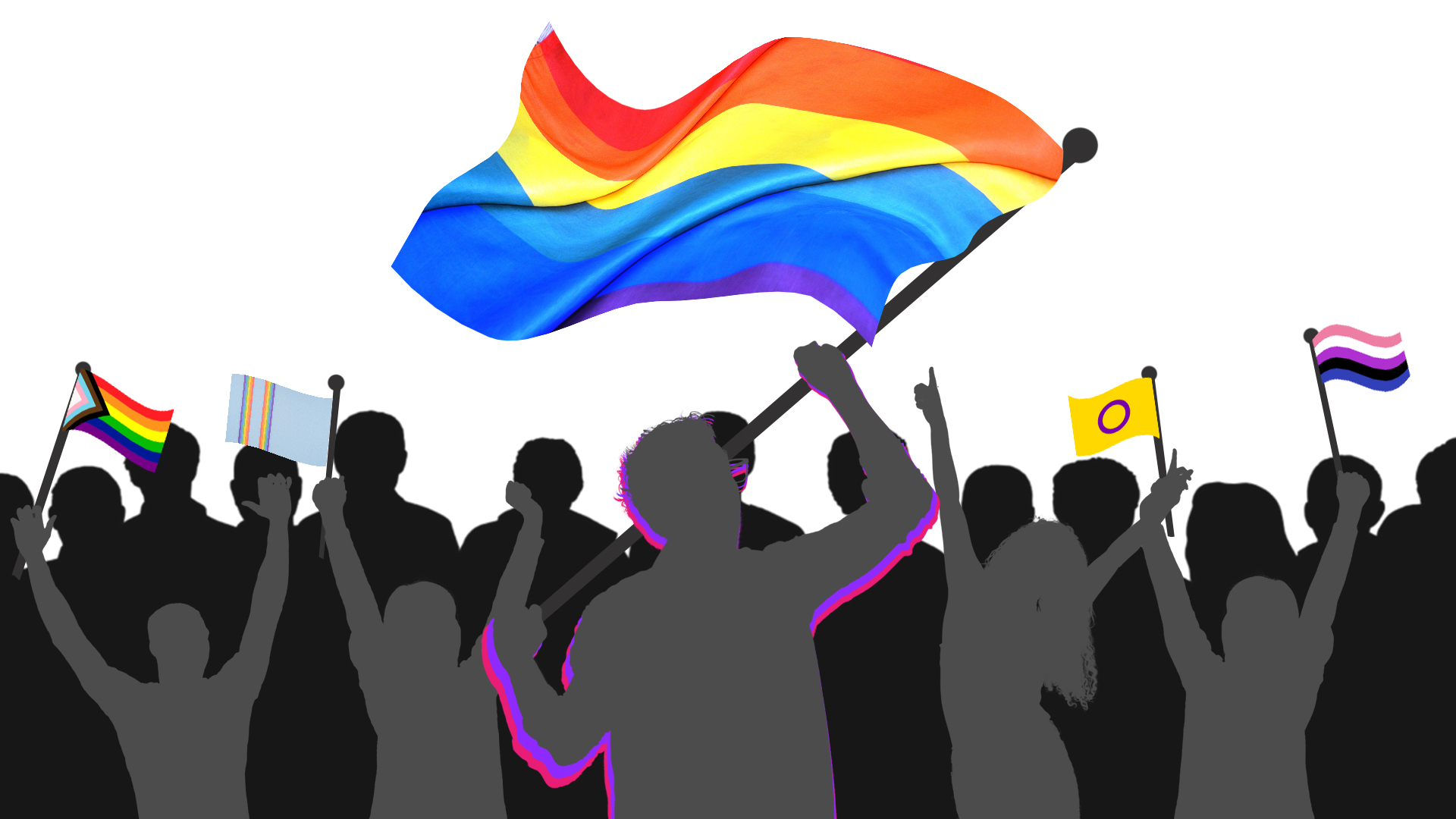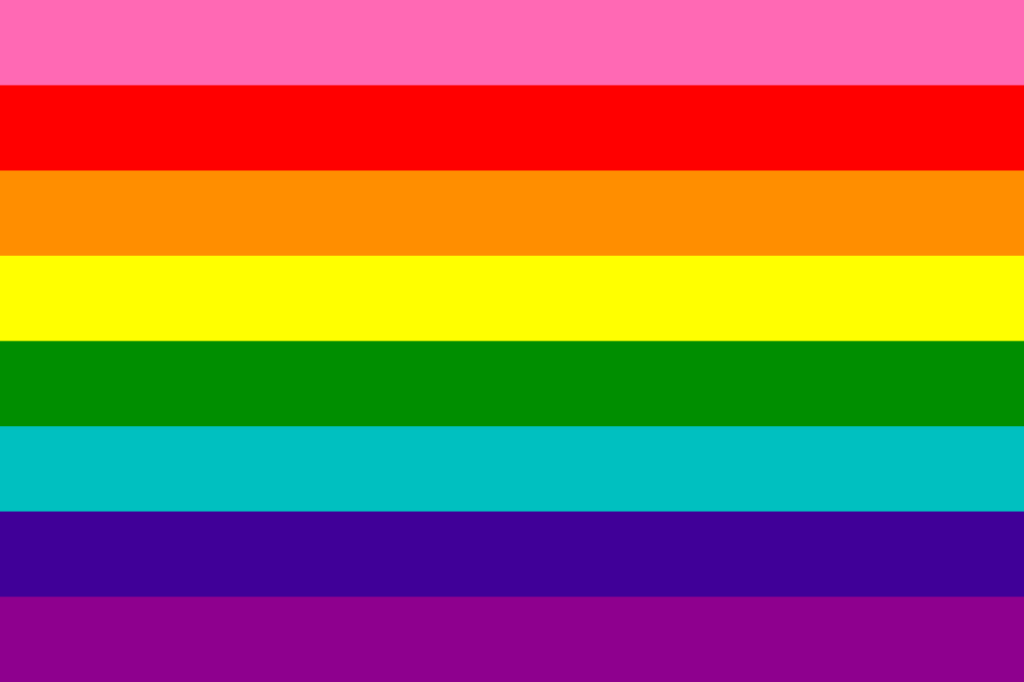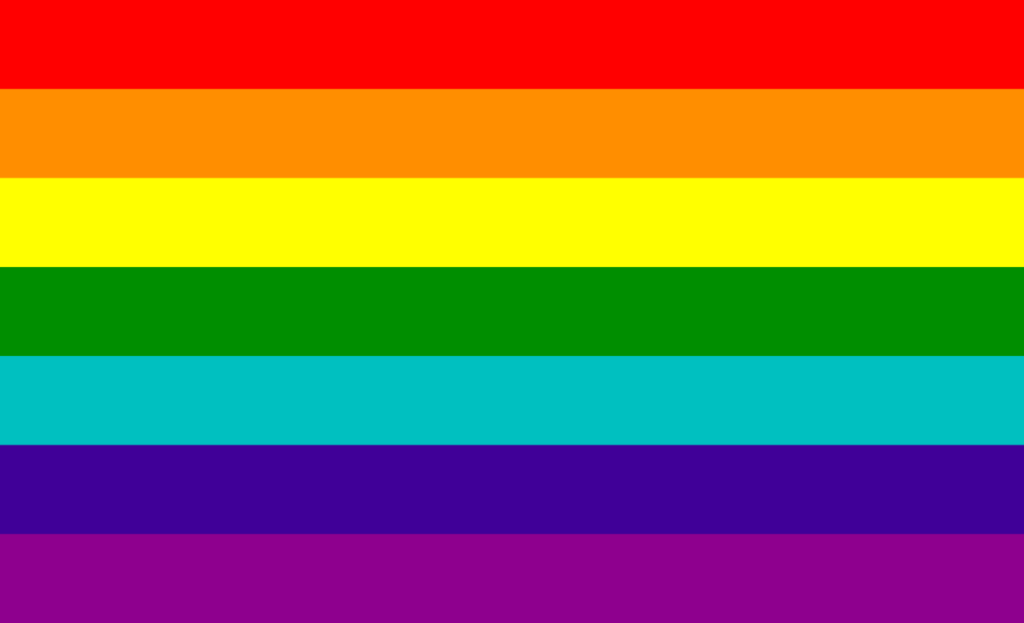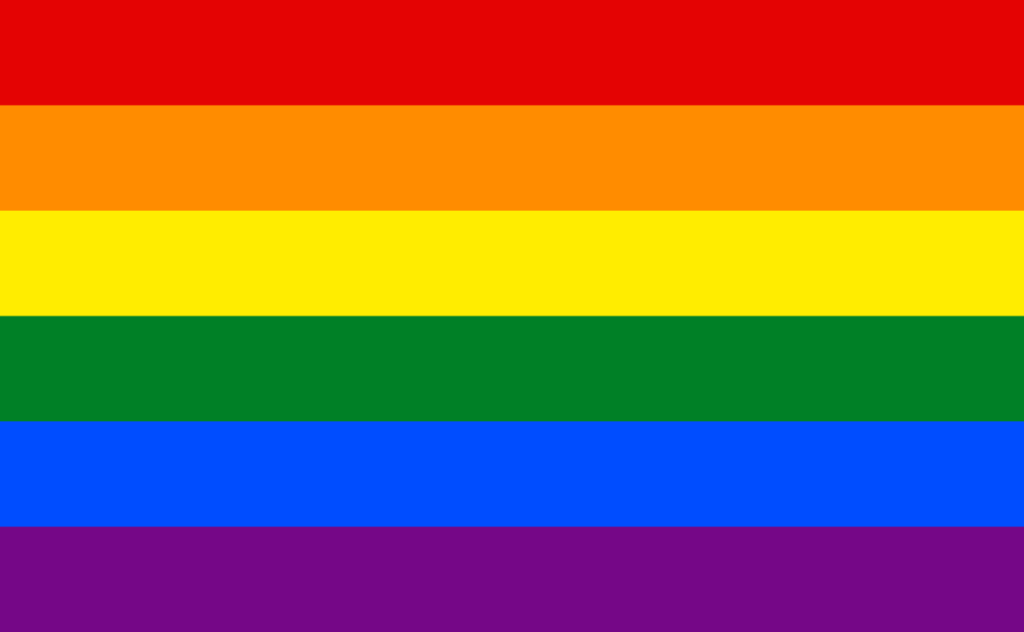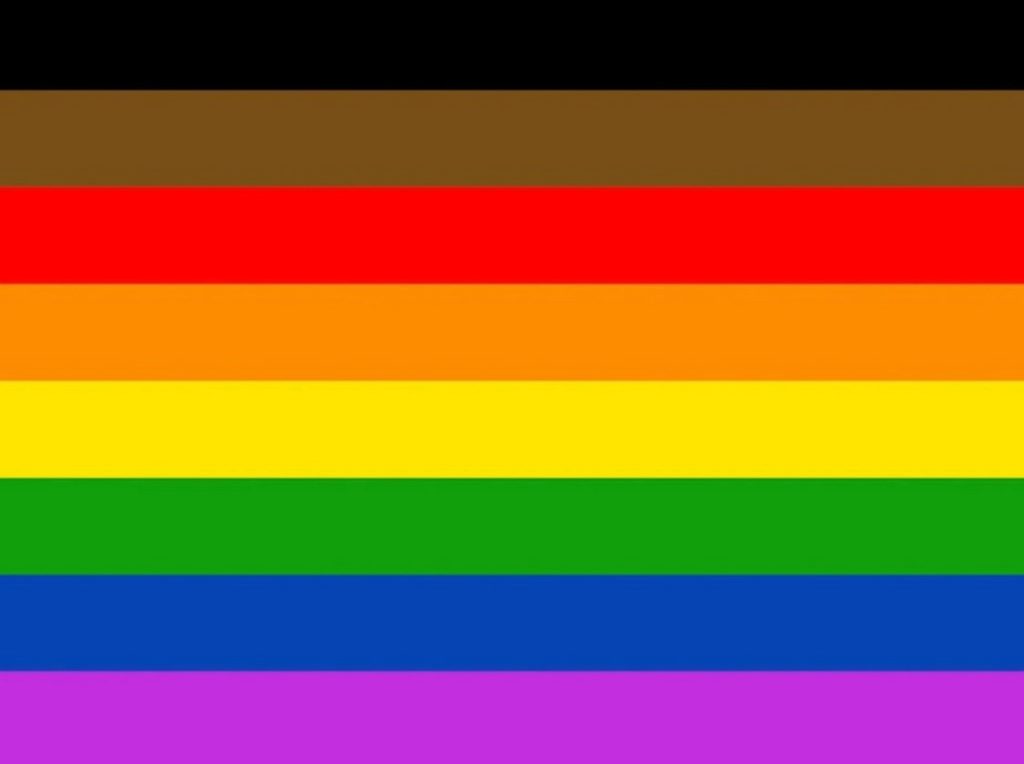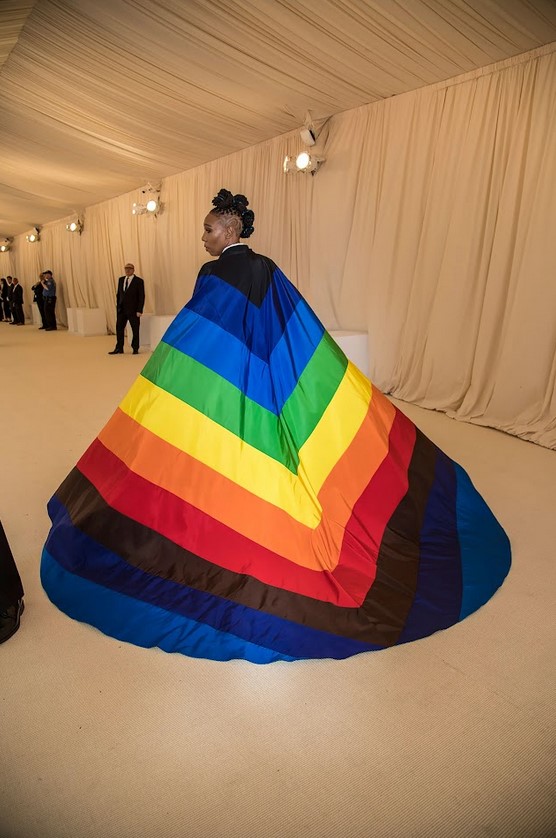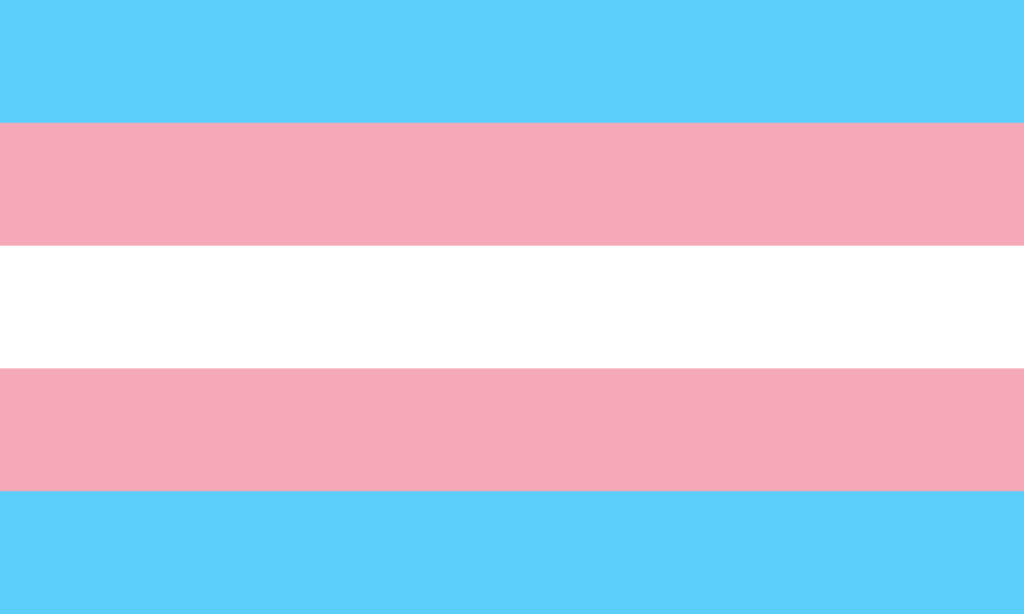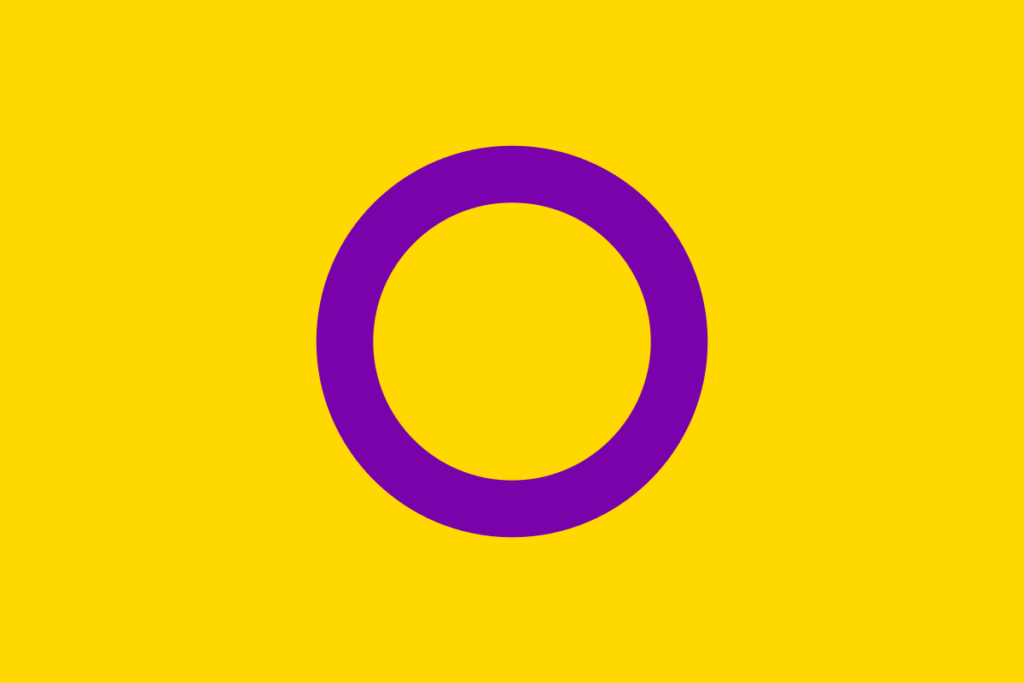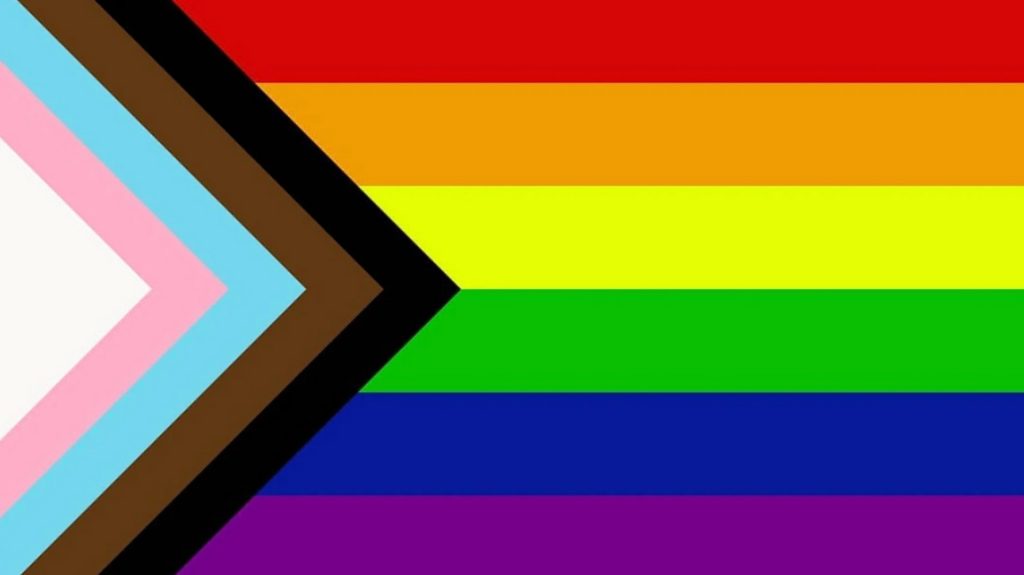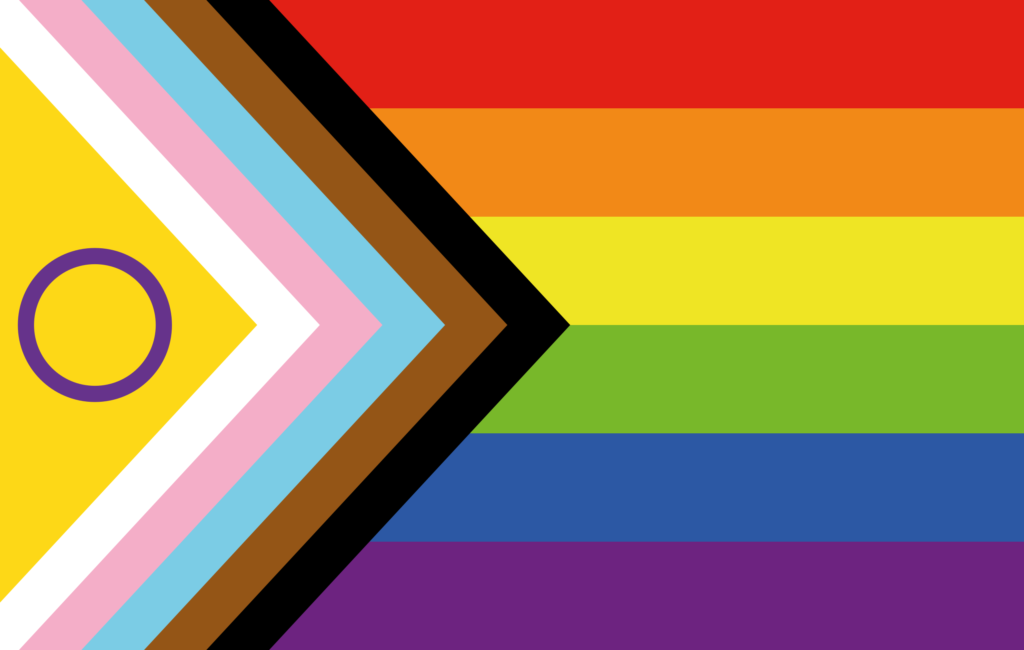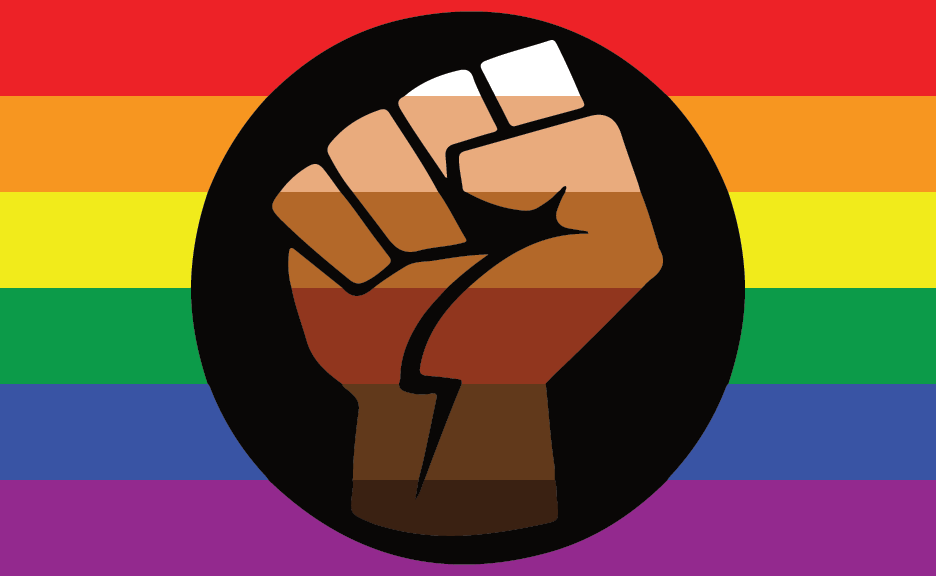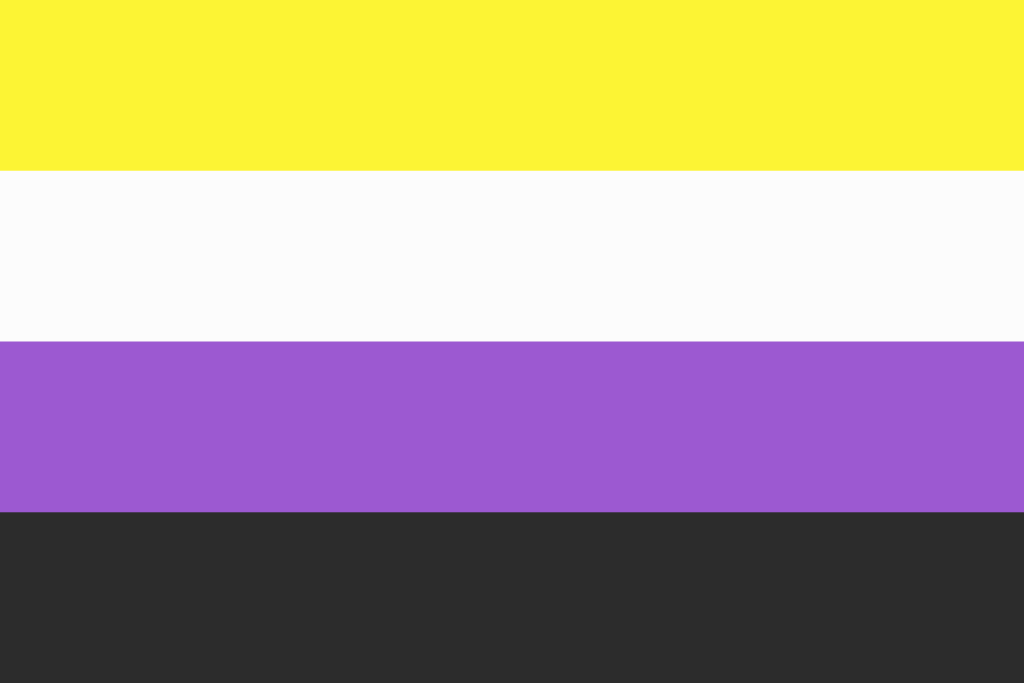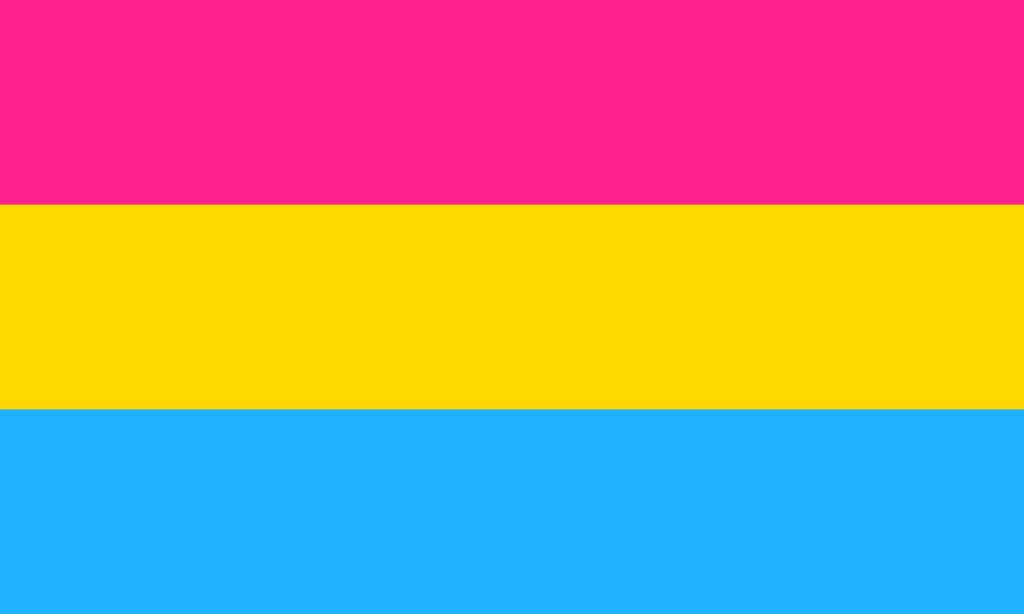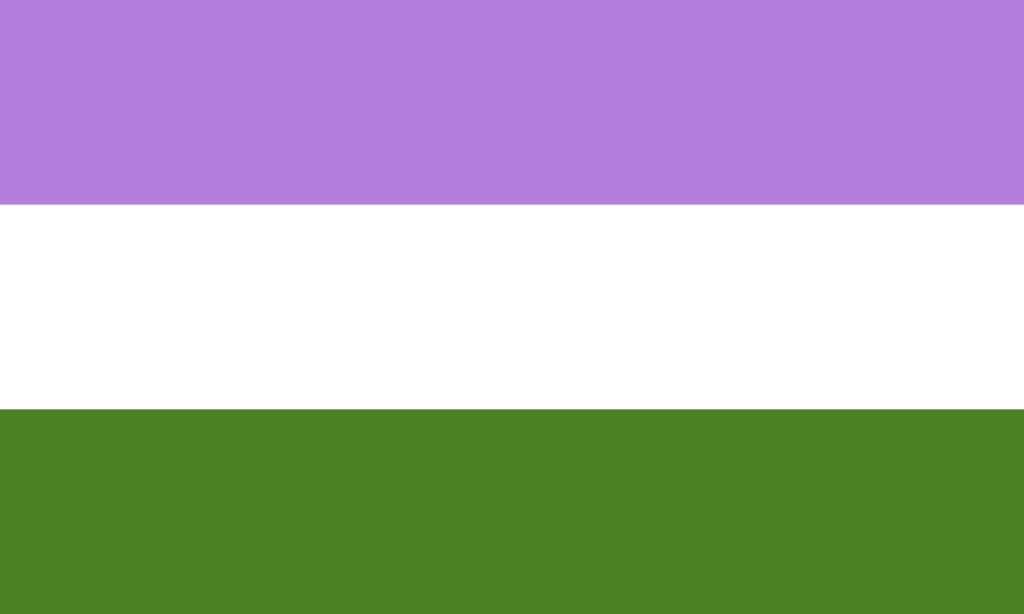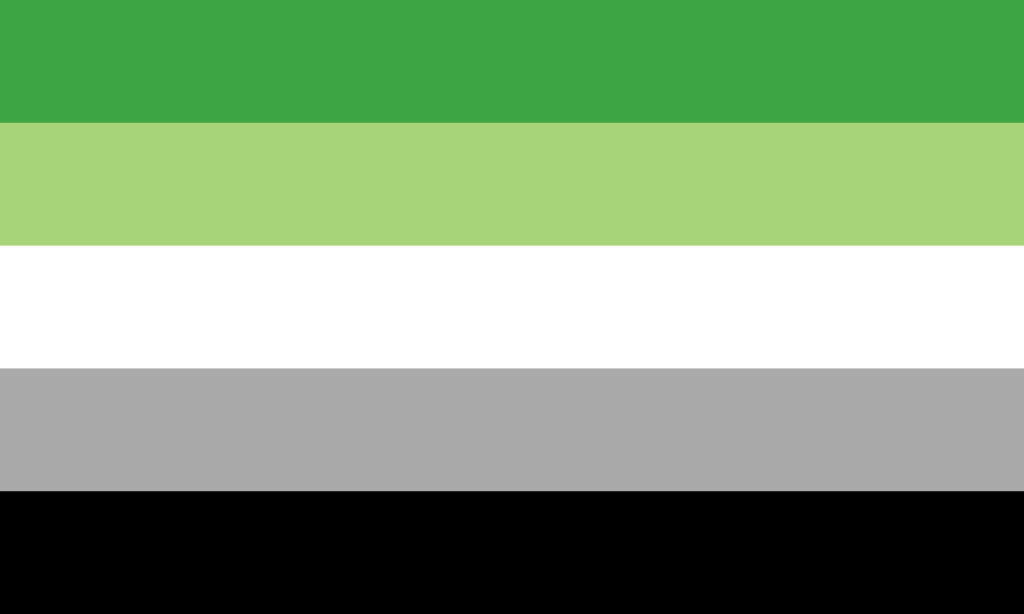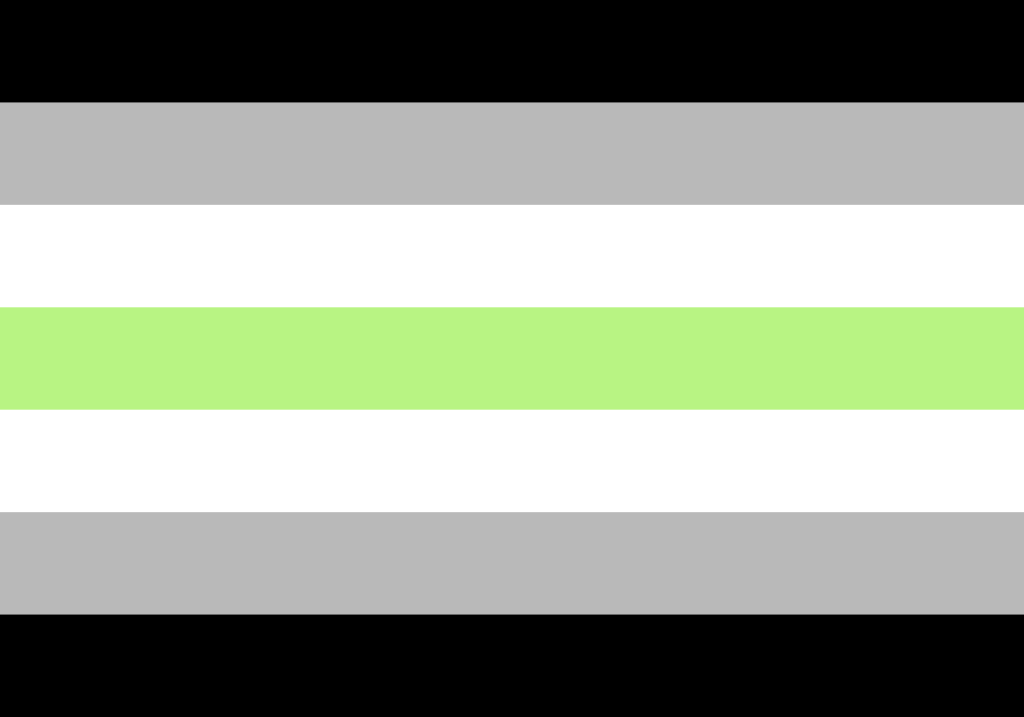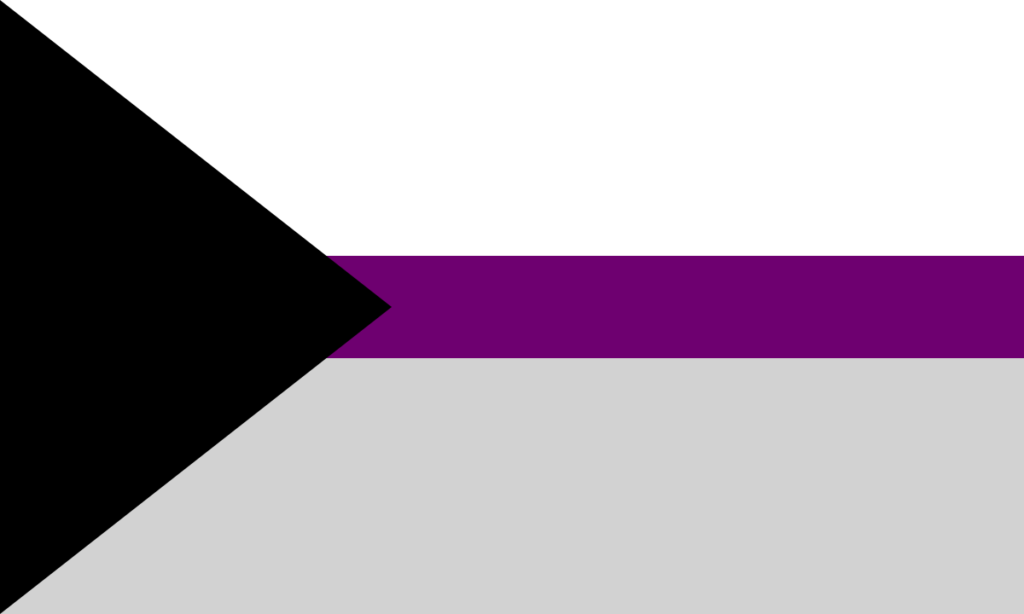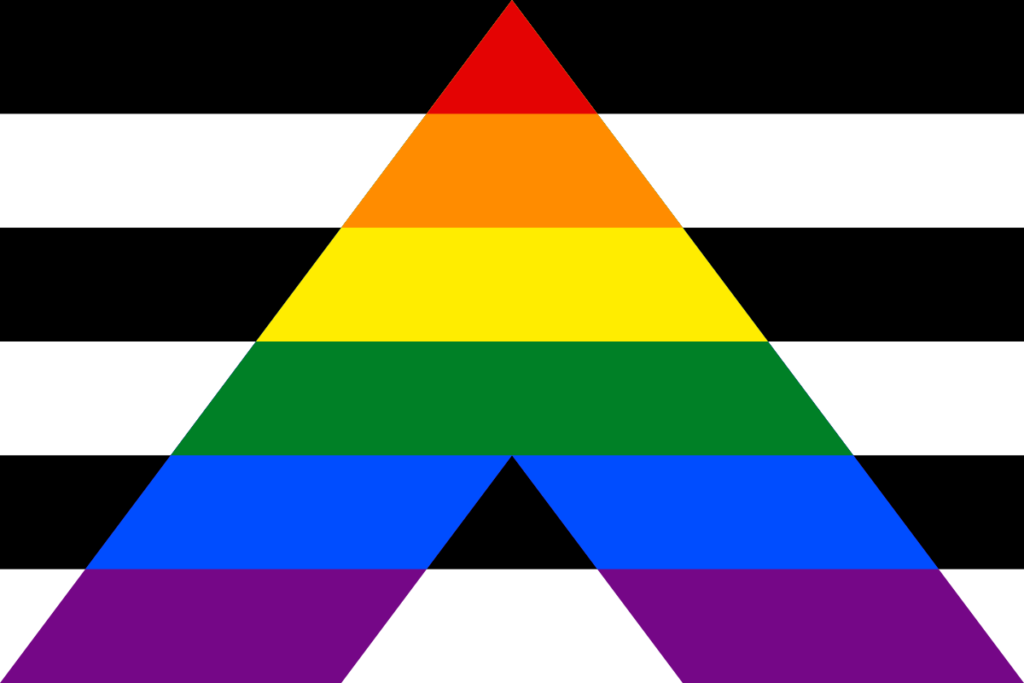We are now well into Pride Month, one of the most colorful times of the year. With rainbows everywhere, this isn’t the only color combo that symbolizes the LGBTQIA+ community.
During this monumental month, people proudly raise their flags to symbolize the love and camaraderie within the LGBTQIA+ community. As pride and society continue to progress, there have been many renditions of pride flags popularized throughout history. Combined with the proliferation of social media, there have been a lot more flags than just the rainbow flag that have become important symbols for the LGBTQIA+ community.
What better way to celebrate pride than by getting acquainted with some (of the countless) flags out there? Learn about the history and meaning of these 18 pride flags that you may see hanging about whether it’s Pride Month or not.
Gilbert Baker Pride Flag
In 1977, Harvey Milk, the first openly gay politician to be elected to office in California, gave Gilbert Baker the privilege (and pressure) of designing a flag to represent the LGBTQIA+ community.
Gilbert Baker was an artist, activist, and openly gay military veteran. Said to be inspired by the 1939 classic The Wizard of Oz’s song “Over The Rainbow”, Baker created a rainbow flag containing 8 colors.
“A Rainbow Flag was a conscious choice, natural, and necessary,” Baker said about his iconic flag. “The rainbow came from the earliest recorded history as a symbol of hope,” referring to God’s promise to Noah (of Noah and the Ark fame) and his family at the time after the great flood.
In 2015, Baker told CNN that “we needed something to express our joy, our beauty, our power. And the rainbow did that,” with each of the 8 colors having its own special meaning.
Hot Pink – sex
Red – life
Orange – healing
Yellow – sunlight
Green – nature
Turquoise – magic and art
Indigo – serenity
Violet – the spirit of the LGBTQ people
“We’re an ancient, wonderful tribe of people,” Baker said. The creator of the flag that started it all, Baker expresses that “We picked something from nature. We picked something beautiful.”
Updated Rainbow Flag (7-colored flag turned 6)
There have been two updates to the original Gilbert Baker rainbow flag. On November 27, 1978, Harvey Milk was assassinated, and there was an increasing demand for the rainbow flags. Baker decided to forgo the hot pink color because of the difficulty to find this fabric for production.
One year later, Baker chose to remove another color – turquoise – from the flag. This would allow the flag to be split into an even number of colors. This later became the standard flag representing the LGBT community. It was also adopted by allies and businesses during Pride Month.
Philadelphia Pride Flag
In 2017, Philadelphia launched its “More Color More Pride” campaign. Black and brown stripes were added to the rainbow flag to represent LGBTQIA+ people of color who were not always included/considered in public gay rights movements in the past.
This flag also gained traction after American actress, producer, and screenwriter Lena Waithe donned the flag as her cape at the 2018 Met Gala.
Transgender Flag
Created in 1999 by trans woman Monica Helms, this flag utilizes the colors we most associate with baby boys and baby girls. Monica Helms is the founder of the Transgender American Veterans Association (TAVA), being a US Navy veteran herself.
According to Helms, the white in the middle represents the intersex members of the community, those who are in the process of transitioning, as well as those who do not identify with any gender.
The design of the flag was also done in such a way that no matter how you hold it, it will always be right-side up. This may also symbolize our constant search for “correctness” in our lives.
Intersex Flag
In 2013, Morgan Carpenter came up with the intersex flag as the president of Intersex Human Rights Australia. Intersex people have bodies that differ from the standard binary of male and female. This may be caused by (but is not limited to) varying chromosome combinations and/or being born with both genitals.
Like the non-binary flag, intersex flag creator Morgan Carpenter wanted to deviate from the colors generally associated with gender.
Purple and yellow are generally viewed as gender-neutral colors. The simple but solid circle at the center of the flag is meant to represent the wholeness of intersex people. The unbroken circle serves as a reminder that intersex people are perfect as they chose themselves to be.
Carpenter has described the intersex community as “still fighting for bodily autonomy and genital integrity,” adding that “this symbolizes the right to be who and how we want to be.”
Progress Pride Flag
A symbol of the evolving nature of Pride and the LGBTQIA+ community, the Progress Pride Flag is the culmination of many flags into one. In 2018, non-binary artist Daniel Quasar designed the progress pride flag. Adding that the black and brown stripes were also meant to represent those living with HIV/AIDS, those who’ve passed away from it, and the general stigma that still surrounds the sickness to this day. This flag has been seen as a response to the Philadelphia Pride Flag.
Just last year, this flag was updated to further promote inclusivity by giving more visibility to the intersex community. Intersex writer Valentino Vecchietti added to this design to include intersex representation in the progress flag. This has become the modern pride flag, celebrating diversity and inclusivity.
Queer People of Color Flag
Adding a raised fist with different skin tones to the 6-colored rainbow flag, the Queer People of Color Flag (QPOC) was popularized at the height of the Black Lives Matter movement.
Along with showing support for the BLM movement, the flag also brings together the experience of the queer and Black communities. Although it’s uncertain as to who exactly created this flag, the raised fist is believed to represent unity as well as boldness and resistance.
Non-binary Flag
This flag was created in 2014 by Kye Rowan when they were 17 years old. Meant to represent the people whose gender identities do not conform with the traditional male/female binary, each color on the flag attests to this.
Yellow – represents the people who generally identify as being outside of the cisgender male/female binary
White – as the presence of all colors, white represents multi-gendered people
Purple – people who incorporate a combination of both male and female aspects which may or may not fluctuate for them
Black – as the absence of color; represents those who feel like they have no gender/do not identify with a specific gender (agender people)
Asexual Flag
Created in 2010, the asexual flag was made by the Asexual Visibility and Education Network (AVEN), inspired by its logo.
Asexuality may be considered as an umbrella term, with its precise definition deferring depending on who you ask. It may center on one’s lack of sexual attraction towards others, but it may also include being uninterested in sexual activity and/or favoring other types of attraction more/rather than sexual attraction. The many meanings for the umbrella term are embedded in the meanings of each color found within the flag.
Black- asexuality in general
Gray- refers to gray-asexual people, those who are mostly asexual but still take part in sexual activities from time to time; the color gray may also represent the demisexual community (those who need to form a deep emotional bond with someone before being able to develop any sense of sexual attraction with them)
White- non-asexual partners and allies of the asexual community
Purple- the asexual community
Bisexual Flag
Created by Michael Page in 1998, this flag is all about the blending of a person’s attraction from one gender to another just like what bisexuality is all about. This may be seen in the way that pink and blue are on the outer edges of the flag, and in the center is purple which is a combination of the two colors.
More specifically the colors represent:
Pink- attraction to the same gender
Blue- attraction to a different gender
Purple- bisexuality, the attraction to two or more genders
Lesbian Flag
The previous design of the lesbian flag originally came with a red lipstick kiss and was only made up of varying pink to red shades mimicking the varying shades of lipstick.
Not all members of the lesbian community felt like they were represented by this flag, like, for example, the butch lesbians. This design was further forgotten when the creator of this in 2010, Natalie McCray was known to have transphobic and racist ideologies.
The result of all this turmoil is the new and improved lesbian flag containing shades of pink to orange. Emily Gwen created this flag in the hopes of encapsulating all lesbian subgroups under the lesbian community, uniting them all under one flag with meaningful colors.
Dark orange – gender non-conformity
Orange – Independence
Light orange – community
White – relationships/connections unique to womanhood
Light pink – serenity and peace
Pink – love and sex
Dark pink – femininity
Pansexual Flag
Created in 2010 with the original artist unknown, this flag represents those who are attracted to a person regardless of what their gender identity may be. The meaning of each color on this flag is similar to that of the bisexual flag in the way that they represent the different attractions that pansexual people have.
Pink – attraction to women
Blue – attraction to men
Yellow – attraction to those who don’t identify with the gender binary
Pansexuality is sometimes viewed as a branch of bisexuality, though it may also be considered a more inclusive term for this. The creation of the flag aims to differentiate it from bisexuality. Pansexuality rejects the gender binary.
Gender Fluid Flag
Created by J.J. Poole in 2012, the 5 colors represent what the gender fluid community is all about. With each color, the flag emulates the fluid nature of those who identify as gender fluid – shifting from different areas of the gender spectrum.
Pink – feminine
White – all genders
Purple – a combination of the masculine and feminine
Black – a lack of gender/ androgyny
Blue – masculine
According to Poole, the flag became popular after they submitted it to a Tumblr blog that centered on genderfluidity and gender fluid people. After receiving much love from this blog, the flag just “took off”.
Genderqueer Flag
In 2011, Marilyn Roxie created this flag to unite all genderqueer and non-binary people, although Kye Rowan would later create their own flag for all non-binary people specifically. Similar to being non-binary, those who identify as genderqueer do not see themselves as fitting under one category of the male/female gender binary. While the two terms may sometimes be exchanged with one another, genderqueer may be seen as the broader, umbrella term, which encapsulates all gender identities outside of heterosexuality.
This flag makes use of three colors to represent the genderqueer community:
Lavender – again, seen as the mix of pink and blue which are traditionally associated with male and female, in this flag it represents androgyny
White – the agender community
Green – the non-binary community
“Queer” is a term that, in the past, was used in a derogatory manner although the LGBT community has fought hard to reclaim it (but some are still uncomfortable with using it/being called this way).
Aromantic Flag
Those who identify as aromantic do not experience romantic attraction, as compared to, for example, asexual people who do not experience sexual attraction.
Dark green – aromanticism
Light green – the aromantic spectrum
White – platonic and aesthetic attraction/relationships
Gray – similar to the gray-asexual, this represents the gray-aromantics who may occasionally feel romantic attraction in certain situations
Black – the sexuality spectrum as a whole
Green was chosen as one of the main colors to be featured as it is viewed as the opposite of red (which is mostly associated with romance/passion).
Agender Flag
In 2014 Salem X designed a flag for all the people who do not identify with any gender (whether within or outside the gender binary).
Black and white – the absence of gender
Gray – semi-genderlessness
Green – non-binary genders
Similar to the transgender flag, the agender flag’s design makes it so that it is always correct no matter what the orientation is.
Demisexual Flag
As mentioned earlier, demisexuals are people who need to make a strong emotional connection before they can experience any sort of sexual attraction toward others.
Black – asexuality
Gray – demisexuality
White – sexuality
Purple – community
Since demisexuality exists under the non-binary spectrum, the colors are similar to the non-binary flag, although it has its own unique layout.
Straight Ally Flag
Overlaying a rainbow-shaped letter “A” on a black and white background has become the flag for allies of the LGBTQIA+ community.
Allies are any heterosexual/cisgender people who believe in the need for equal rights and fair treatment of all those who are a part of the LGBTQIA+ community.
With the numerous flags out there, and the help of the internet spreading a thousand ideas all at once, there has been some debate as to which flag is considered the “official” one to represent a certain group under the LGBTQIA+ community.
What’s important during this Pride Month is to find the one that speaks to you the most (because there are truly many more out there). This month is all about visibility and celebrating the unique experiences that we all have, and how love unites them (and us) to one another – no matter what pride flag we choose to raise.
Other POP! stories you might like:
15 books with LBTQIA+ stories to read this Pride Month
A quick dive into the history of the LGBTQIA+ community in the Philippines
10 local organizations that foster safe space for the LGBTQIA+ community

